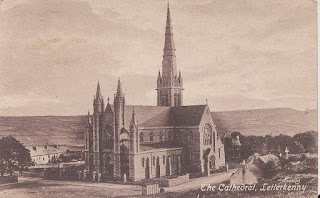Our Pilgrimage culminated in the celebration of the Holy Sacrifice of the Mass in the Extraordinary Form the Roman Rite.
Samuel Lewis' Topographic Dictionary of Ireland tells us that the ancient geoographer Ptolomy referred to Emly in his second century writings as "Imlagh" one of the three principal towns of Ireland. St. Prosper of Aquitainerecords that Pope Celestine sent Palladius in 431 "to the Scots believing in Christ, to be their first bishop"
We know of four pre-Patrician Saints of Ireland, St. Ailbe of Emly, St. Declan of Ard More, St. Ciaran or Abban and St. Ibar. In the life of St. Declan he is "secundus Patricius et patronus Mumenie" a second Patrick and Patron of Munster.
The Rule of St. Ailbe, a rule of life for his monks, is still extant in 58 verses:
Let him be steady, let him not be restless, let him be wise, learned, pious; let him be vigilant; let him be a slave; let him be humble kindly.The monastery at Emly became the seat of the Diocese of Emly in 1118 at the Synod of Ráth Breasail. The diocese was placed into the administration of the Archdiocese of Cashel after its last Bishop, Blessed Terence O'Brien, was martyred in 1651.
Let him be gentle, close and zealous, let him be modest, generous and gracious; against the torrent of the world, let him be watchful, let him not be reproachful; against the brood of the world, let him be warlike.
The jewel of baptism and communion, let him receive it.
Let him be constant at prayer, his canonical hours let him not forget; his mind let him bow it down without insolence or contention.
A hundred genuflections for him at the Beata at the beginning of the day… thrice fifty psalms with a hundred genuflections every hour of vespers.
A genuflection thrice, earnestly, after going in past the altar rail, without frivolity and without excitement, going into the presence of the king of the angels.
A clean house for the guests and a big fire, washing and bathing for them, and a couch without sorrow.
This place, noticed under the name of "Imlagh" by Ptolemy, as one of the three principal towns of Ireland, is of very remote antiquity, and was formerly an important city and the seat of the diocese. A monastery of canons regular was found here by St. Ailbe, or Alibeus, who became its first abbot, and dying in 527, was interred in the abbey. His successors obtained many privileges for the inhabitants. The abbey and town were frequently pillaged and burnt. King John, in the 17th of his reign, granted the privilege of holding markets and fairs in the town, which, since the union of the see of Emly with that of Cashel in 1568, has gradually declined, and is now comparatively an insignificant village, containing only 115 houses. It has a constabulary police station, and fairs are held on May 21st and Sept. 22nd.
The present Church was built about 1880 and houses a stunning collection of stained glass windows, well worth visiting.






























































